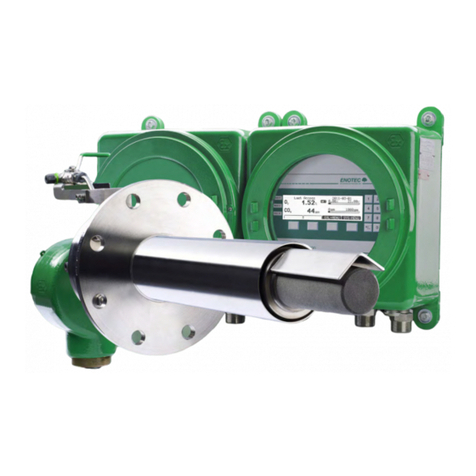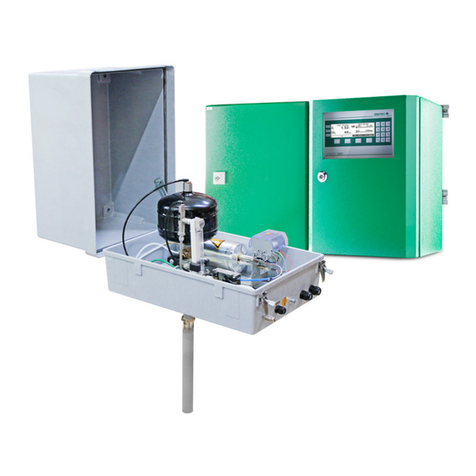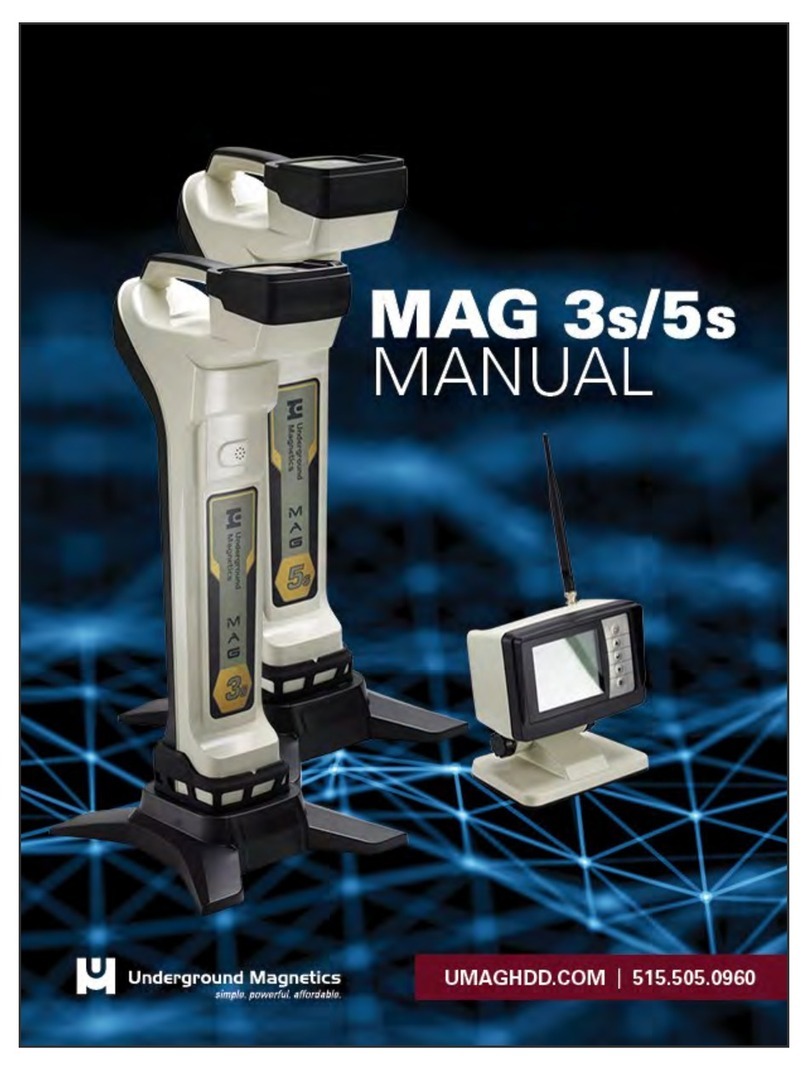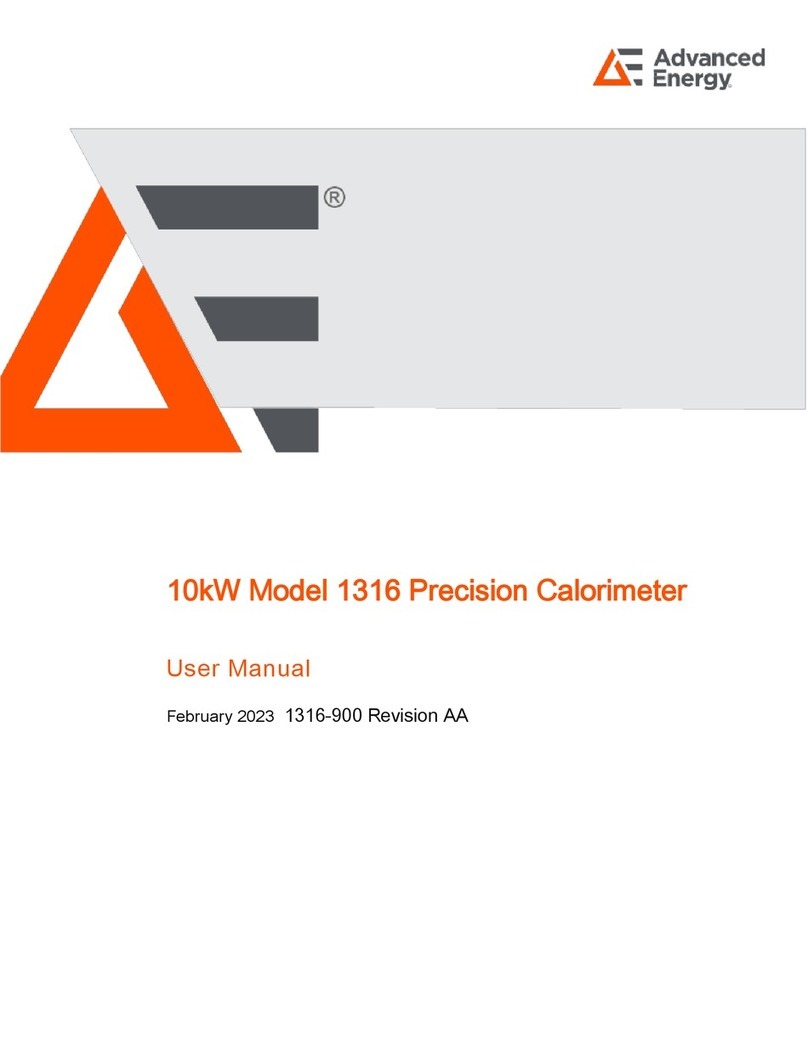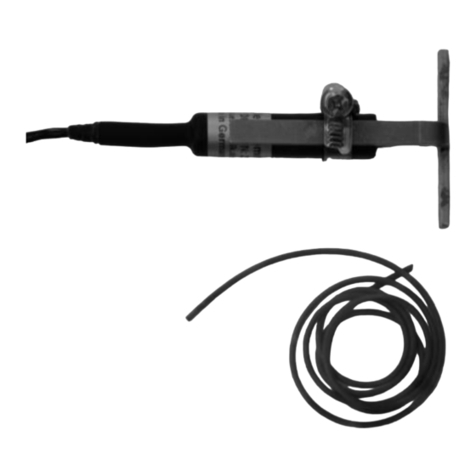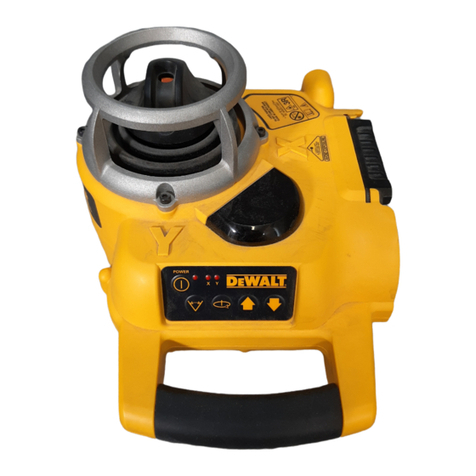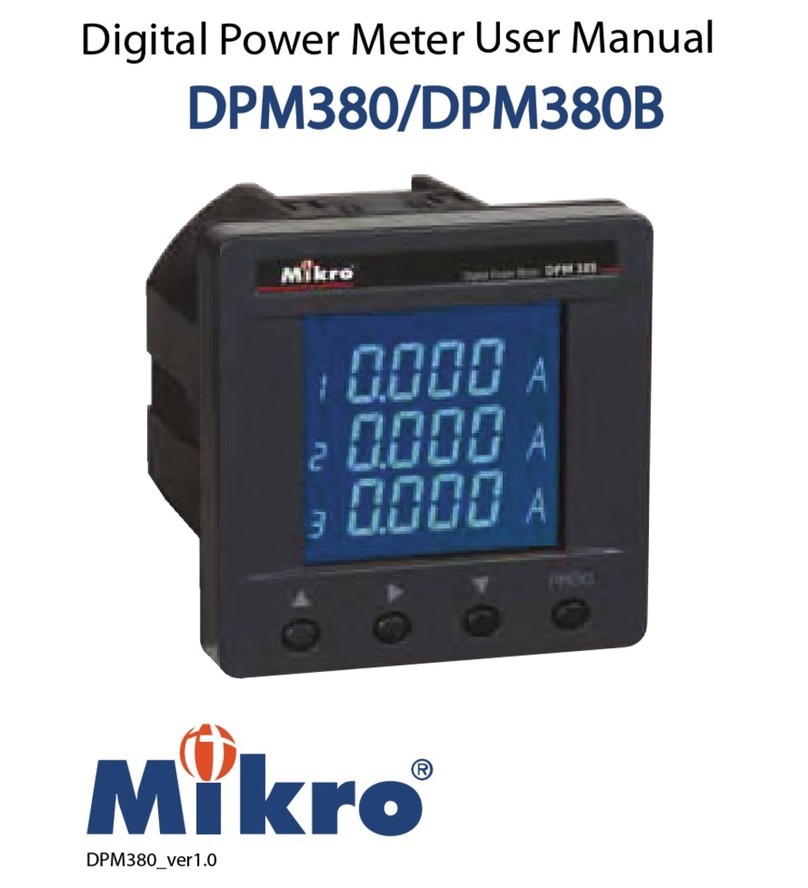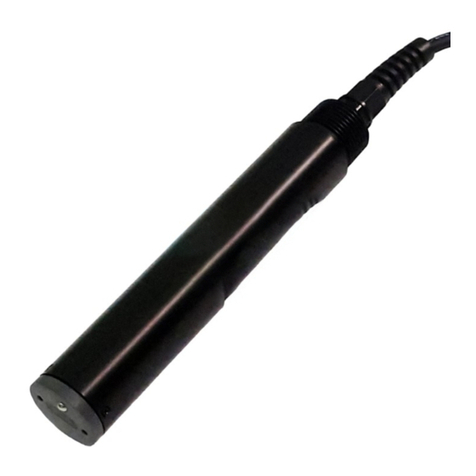Enotec COMTEC 6000 DustEx User manual

Doc.-ID: COM_OXI_Dust_11022020
Installation and Operation Manual
COMTEC
®
6000 ATEX – DustEx
O
2
/ CO
e
Analyzer System
OXITEC
®
5000 ATEX – DustEx
O
2
Analyzer System
Version 05
OXITEC Software Version: 4.13
COMTEC Software Version: 4.13

Preface
Dear Customer,
Thank you for selecting ENOTEC for your InSitu Flue Gas measuring system.
For more than 35 years now ENOTEC's Analyzer Systems have been operating in numerous applications with thousands of
units being produced and shipped around the world.
ENOTEC is committed to total quality and performance and we have continuously enhanced our products to integrate various
features and functions. In this package, the electronic unit uses the very latest Microprocessor Technology, making the SME5
electronic unit one of the most advanced and up-to-date monitoring units, permitting you to reduce your maintenance & fuel
costs, and to achieve increased measuring accuracy with more operational reliability using these new monitoring functions.
In all measuring probes you will find that the O
2
Sensor is soldered in place using a special process and technique developed by
ENOTEC. This results in a considerably increased service life compared to „glued or cemented“ competitors measuring cells,
which have a tendency to leak or crack during operation. ENOTEC's sensors have a proven gas gas-tight design, providing
greater measuring accuracy, durability and longer working life time.
All ENOTEC instruments are thoroughly tested in the factory and are subject to a strict ISO9001 Quality Assurance Procedure.
Therefore, with the correct installation, the operation of the analyzer is very straightforward and user friendly and will provide
you with many years of trouble free operation with perfect measuring results.
Notes concerning this Manual
This manual contains important information concerning the design, installation, commissioning, operation, maintenance and
troubleshooting. To work safely with the analyzer, become familiar with all warnings, safety instructions and maintenance tasks
of this manual.
Symbols used in this Manual
Important information as well as safety instructions are emphasized by the below-mentioned symbols. Make sure that all safety
advice and warnings are observed at all times.
Warning
Follow all instructions in this manual
Consider Information
Points out important information which must be
noted before execution
Warning hot Surface
Warns of danger of burns which could occur from
hot system parts
Info
Contain further detailed information
Caution
Warns of risks by destroying the system or its
components or its functionality
Ground earth electrical protection
The contents of this manual are protected by copyright. Alterations and errors reserved.
Safety Instruction
The analyzer is operated with line voltage. After removal of terminal covers some parts of the system may be accessible
which could be already under high line voltage.
Only well trained and authorized personnel are allowed to work on this system. Personnel must know and understand all
precautions, safety instructions, installation and maintenance instructions of this manual. The trouble free and safe operation
of the system requires safe transportation, professional storage, installation, operation and maintenance.
Furthermore all local safety requirements at that point of installation and operation must become considered.
The analyzer system is a system for measuring the oxygen concentration in flue gases and other non-combustible gases. For
reasons of safety and the possibility of accidents, unauthorized conversions and modifications of the system are prohibited
The device may only be put into operation if the enclosed instructions have been fully understood.
This manual is also available in other languages on request.

Installation and Operation Manual - DustEx Table of Contents
Doc.-ID: COM_OXI_Dust_11022020 1
Table of Contents
1System Description 1
1.1Distinction between COMTEC / OXITEC DustEx 1
1.2System Overview 1
1.3Measuring principle 2
1.4Intended use 2
1.5Safety Hazards 2
1.6Disruption of the Process 2
1.8Storage instructions 3
1.9Name Plates 4
2Installation 5
2.1Installation Requirements for Electronic Unit 5
2.2Installation Requirements for Probe Cable 6
2.3Access to the Terminals 7
2.4Fitting of Ferrite Sleeves 7
2.5Wiring Diagram of the Electronic Unit 1
2.6Electrical Wiring Diagram - OXITEC DustEx 2
2.7Electrical Wiring Diagram - COMTEC DustEx 3
2.8Installation of the probe 4
2.9Mounting of the Counter Flange at the Duct 5
2.10Adjusting the V-shield 5
2.11Mounting of the Probe 6
2.12Electrical Connections of the Probe 6
2.13Requirements for Pneumatic Cable FEP-0002 7
2.14Preparation of the pneumatic cable 8
2.15Pneumatic Connections of the Probe 8
2.16Pneumatic Connections of the Electronic Units 1
3Initial Operation 2
3.1Checklist before commissioning the system 2
3.2System Power Up 2
3.3Display - Probe Heating Phase 3
3.4Display - Measuring Mode 3
3.5Keypad and Display 3
3.6Status LEDs 4
3.7Softkey Symbols 4
3.8System Code 4
4Menu Overview and Explanations 5
4.1Menu Overview - SYS-MENU 5
4.2Menu Explanations - SYS-MENU 1
4.2.1O2Measuring Ranges (Scaling) 1
4.2.2Limit alarm settings 1
4.2.3O2Sensor calibration values 1
4.2.4Measuring value averaging for 1
4.2.5mA output on system errors 1
4.2.6COe Measuring Ranges (Scaling) 2
4.2.7COe Sensor Calibration values 2
4.2.8Time per test gas apply 2
4.2.9Delay time to process 2
4.2.10Pre-purge time 2
4.2.11Automatic Calibration (ACAL) 1
4.2.12ENOTEC REMOTE 2
4.2.13Measuring units 2
4.2.14Language 2
4.2.15Change system code 2
4.2.16Load factory settings 3
4.2.17Set COe measurement to off/on 3
4.2.18Service 3
4.3System Checks 4
4.4CAL MENU 5
4.4.1Calibration Menu - Display Overview 5
4.4.21-point calibration (O2and/or COe) (manual) 6
4.4.32-point calibration (O2and/or COe) (manual) 6
5Service and Maintenance 7
5.1Exchange fuses 7
5.2Flow Rates for Test Air and Reference Air 8
5.3Adjusting Flow Rate (SME 53 with integrated
Pneumatics) 8
5.4Position of the adjustment valves 9
5.5Adjusting Flow Rate (SME-54) 9
5.6Replacing the Filter Head 10
5.7Replacing the probe 10
5.8Exchange of Probe Inner Parts 11
5.9Replacing the O2Sensor 12
5.10Replacing the COe Sensor (COMTEC) 13
5.10.1Seal the COe sensor guide tube 14
5.11Relay Outputs / Functions and Correlations 15
5.12Digital Inputs 16
5.13Stability Criteria for Calibration 16
5.14Reaction Time of the mA Output............................16
5.15Extension Modules.................................................16
5.16Maintenance Intervals............................................16
6Status Messages 17
6.1Error Messages......................................................17
6.2Alarm Messages ....................................................19
6.3Service Messages..................................................19
6.4Heater Control Unit ................................................20
7Troubleshooting 21
ATechnical Data 23
A.1Electronic Unit........................................................23
A.2Probe......................................................................24
A.3Requirements for the Gas Supply.......................... 25
BDimension Drawings 26
B.1Dimensions of the Electronic Units ........................26
B.2Probe Dimensions..................................................27
B.3Counter Flange Dimensions...................................28
B.4Probe Components................................................29
B.5Gas plan.................................................................30
CSpare Parts 31
C.1Mounting Plates of the electronic Unit ...................31
C.2Display Board.........................................................32
DWarranty 33
EDeclaration of Conformity 34
Index 36


Installation and Operation Manual - DustEx System Description
Doc.-ID: COM_OXI_Dust_11022020 1
1 System Description
1.1 Distinction between COMTEC / OXITEC DustEx
The OXITEC 5000 ATEX DustEx and COMTEC 6000 ATEX DustEx systems differ only in regard to the optional CO
e
sensor.
The OXITEC 5000 ATEX DustEx system includes an O
2
sensor only.
The COMTEC 6000 ATEX DustEx system includes both O
2
and CO
e
sensors.
There are no constructive differences between both systems.
Info
References to the CO
e
sensor are only applicable to the COMTEC 6000 DustEx analyzer system.
1.2 System Overview
Figure 1 - System overview
Electronic unit SME5 / IP66 Safe Area
Max. ambient temp.: -20 °C to +55 °C (-4 °F to +131 °F)
In-Situ measuring probe / IP6X Potentially explosive atmosphere (Dust Ex)
Max. ambient temp.: -20 °C to +70 °C (-4 °F to +158 °F)
Pneumatic cable Duct / combustion chamber
O
2
probe signal cable Flue gas direction – max. flue gas temperature 600 °C (1112 °F)
Counter flange (Optional) Manufacturer supply
Isolation: Customer Customer supply
Duct wall Power supply
Test gas in
Output signals (analog and digital)
Instrument air in

System Description Installation and Operation Manual - COMTEC
®
/
OXITEC
®
DustEx
2 Doc.-ID: COM_OXI_Dust_11022020
1.3 Measuring principle
The DustEx analyzer system consists of an in-situ probe which is installed in a duct to measure non-combustible
process gases and of an electronic unit for voltage and gas supply, as well as for signal processing.
The O
2
sensor of the COMTEC 6000 is at the tip of the probe and is regulated to 800 °C and works on the zirconium
oxide principle of measurement. Here, a mV signal between the reference gas side of the sensor (inside, instrument
air 20.95% O
2
) and the measured gas side is measured, which depends logarithmically on the ratio of oxygen partial
pressures on both sides of the sensor. The mV signal is converted according to the Nernst equation into oxygen
partial pressure within the process gas, whereby the O
2
concentration is determined in the process gas. Gas-tight
separation of reference air and process gas is of particular importance.
In addition, for the COMTEC 6000 DustEx, the CO
e
sensor at the tip of the probe detects combustible, gaseous
molecules whereby the measured value corresponds to the CO equivalent (CO
e
= CO equivalent). This value can be
used as an indication of the combustion efficiency. A high COe value correlates with poor efficiency because a
portion of the fuel is not completely oxidized. The InSitu sensor is in contact with the sample gas with both electrodes.
These catalytically active electrodes cause oxidation of the non-oxidized gas molecules, so that a voltage is
generated between the electrodes, which depend on the COe concentration. Thus CO, H2 and CxHy (Hydrocarbons)
can be measured.
1.4 Intended use
Info
The OXITEC
®
5000 GasEx analyzer measure in flue gases of combustion plants or in comparable inert
gas mixtures. If oxidizable gas components are contained in these processes, contact ENOTEC.
For reasons of safety and the possibility of accidents, unauthorized conversions and modifications of the
system are prohibited..
Warning
The system cannot be used to determine the O
2
or O
2
/CO
e
concentration in combustible gases or in a
location where combustible gases are present as the measuring cell temperature of 800°C could present
an explosion hazard!
Caution
The maximum ambient temperature for the electronics is 55 ° C (131 ° F) and the terminal box on the
probe 70 ° C (158 ° F). These ambient temperatures must not be exceeded in any case. For use at high
ambient temperatures, check with ENOTEC!
Warning
The minimum concentration of O
2
in flue gas should under normal process conditions, not be less than
0,5%.If the O
2
concentration is regularly below 0,5%, we recommend the option of
CSP (Cell Surface Protection) to protect the O
2
sensor (for OXITEC 5000 DustEx only).
1.5 Safety Hazards
Warning hot surface
During operation, the temperature of the probe filter head and of other parts exposed to flue gas is
150°C - 800°C (302°F - 1472°F). Direct contact with the hot parts when dismantling or maintenance will
cause severe burns!
The probe may only be removed with heat-insulated gloves. Before removing the probe, always switch off
the supply voltage of the electronic system. After removal, store the probe in a safe, protected place and
wait until it has cooled down below 35°C (95°F).
1.6 Disruption of the Process
The analyzer has to be kept in operation also if the process is disrupted or the plant is powered off
temporarily (e.g. at night or during the weekend). Frequently cooling down and heating up of the probe results in
thermal stress of the hot probe parts (heater, thermocouple and sensor) and reduces their product life. ENOTEC will
not accept any responsibility for resultant damage.

Installation and Operation Manual - DustEx System Description
Doc.-ID: COM_OXI_Dust_11022020 3
1.7 ATEX certification
Info
The operating temperature of the probe is 800°C (1472°F). For safeguarding the maximum surface
temperature, the probe switches itself off if the temperature is higher than 810°C (1490°F). The
monitoring of operating temperature takes place redundantly using a thermocouple sheath containing 2
thermocouple pairs. The switch-off is carried out by a mechanism which is independent of the
temperature controller (fail-safe heater control unit, article no.: HCU-0001). After a switch-off of the
heating element the heater control unit must be reset manually by the user.
The probes “KES6001” and “KES6002” are certificated after Directive 2014/34/EU,
„Equipment indended for use in potentially explosive atmospheres”.
The products contain the following markings: ll 2D Ex tb IIIC T133°C/T141°C Db
The number of the EU-type Examination Certificate is: BVS 05 ATEX E 003 X.
1.8 Storage instructions
ENOTEC equipment and spares are to be stored in a dry and ventilated environment at temperatures between
-40 °C to +80 °C (-40 °F to 176 °F). Paint fumes, silicone sprays, etc. must be avoided in the storage environment.

System Description Installation and Operation Manual - COMTEC® /OXITEC®DustEx
4 Doc.-ID: COM_OXI_Dust_11022020
1.9 Name Plates
The name plate contains information regarding line voltage, the nominated current, frequency, protection class, year
of manufacture, serial number, order number and system order code. The system order code contains detailed
system information which is detailed in the system test report and supplied with the system.
Nameplate of the SME-53 electronic unit
COMTEC 6000 DustEx OXITEC 5000 DustEx
Nameplate of the SME-54 electronic unit
COMTEC 6000 DustEx OXITEC 5000 DustEx
Nameplate of the DustEx probe
COMTEC 6000 DustEx OXITEC 5000 DustEx
Figure 2 - Location of the name plates

Installation and Operation Manual - DustEx Installation
Doc.-ID: COM_OXI_Dust_11022020 5
2 Installation
Warning
The system is not equipped with an external power-off switch. The line voltage switch/fuse/breaker must
be installed and be in accordance with local technical standards and should be near to the electronic unit
and must be clearly marked as such. The probe cable is suitable for an ambient temperature range from -
40 °C to +90 °C. All other installed cables must be suitable for the ambient temperature range at side and
must have the required size. All electronic unit terminals are specified from 0,08 mm² (AWG 26) to 2,5
mm² (AWG 14). If wire end ferrules are used the next smaller size is required. Before removal of the
electronic terminal cover the line voltage must be switched off. The line voltage to the electronic unit must
be switched on again after the cover is back in position. After installation power conducting parts may not
be accessible.
2.1 Installation Requirements for Electronic Unit
Keep the minimum distance to adjacent objects
Install at eye level
Avoid vibrations greater than 2g
Mind the IP code
Heavy equipment,
ensure proper lifting
and carrying
Ambient temperatures
Min.: -20 °C (-4 °F) / Max.: +55 °C (+131 °F) - (Pump version -20 °C … +50 °C)
Drill holes for the electronic unit
Use suitable screws
Electronic unit
Figure 3 - Installation of the electronic unit

Installation Installation and Operation Manual - COMTEC
®
/
OXITEC
®
DustEx
6 Doc.-ID: COM_OXI_Dust_11022020
2.2 Installation Requirements for Probe Cable
Warning
The shield of the probe cable must only be connected at the electronic housing at the PE terminal. Under
no circumstance should the shield also be connected at the probe.
Abide by the maximum cable length
(Max. OXITEC pump version cable length – 70m)
Note the minimum bending radius.
FEP-0007R
min
= 234 mm
FEP-0008R
min
= 282 mm
Temp. during installation
Temp. during operation
Cross the probe signal cable (FEP-0007/08) at a right
angle to the power supply cables
No. Function Diameter Colors Info
1 O
2
measuring cell 2 x 0,75 mm
2
white-brown /
brown With shield
2 Thermocouple 1 2 x 0,75 mm
2
green / white With shield
3 Thermocouple 2 2 x 0,75 mm
2
green / white With shield
4 Probe heater 3 x 1,5 mm
2
black / blue /
green-yellow
5 Probe Solenoid valve 2 x 0,75 mm
2
grey / grey-blue
Figure 4 - Probe cable FEP-0007/ FEP-
0008 (armored) 6 Shield of 1, 2& 3bare
7 CO
e
measuring cell 4 x 0,75 mm
2
white/ white/
red/ red

Installation and Operation Manual - DustEx Installation
Doc.-ID: COM_OXI_Dust_11022020 7
2.3 Access to the Terminals
Warning
Before removing the terminal covers, switch off the mains voltage to the system. Switch the mains
voltage on only after attaching the terminal cover. After the installation has been completed, live parts
may no longer be accessible.
Figure 5 -
Access to the Terminals
To connect the wires, follow step 1 to 3.
Figure 6 - Instruction for the connection of the terminals
2.4 Fitting of Ferrite Sleeves
In order to avoid cable related disturbances to the electronic unit, the supplied ferrite sleeves are to be fitted.
CE-conformity is invalid, if these ferrite sleeves are not fitted!


Installation and Operation Manual - DustEx Installation
Doc.-ID: COM_OXI_Dust_11022020 1
2.5 Wiring Diagram of the Electronic Unit
Figure 7 - Wiring diagram of the Electronic Unit
Ferrite sleeves (Enclosed)
A
nalogue output cable (customer)
Power supply cable (customer) Status signal cable (customer)
Probe signal cable Optional pressure transmitter analogue input cable
(OXITEC 5000 DustEx only) (customer)
Internal Power supply
1 L phase
2 N neutral wire Relay contacts for status signals - Potential free
3 PE protection earth 18 A/B Maintenance
1
The output voltage of
these contacts (4…6)
always have the same
voltage as on the
p
ower supply input on
contacts (1…3)
Grounding 19 A/B System Error
4 PE protection earth 20 A/B Output A O
2
measuring range
5 PE protection earth 21 A/B Limit Alarm 1 (O
2
)
6 FE functional earth 22 A/B Limit Alarm 2 (COe)
Shielding Probe solenoid valve
Power supply probe heater (115V) 23 A
Internal Power supply for
probe solenoid valve (115VAC)
8 L black 23 B
9 N blue 24A L grey
10 PE green/yellow 24B N grey/blue
O
2
sensor signal Measuring Range O
2
(12..24V DC - Ext. supply)
12 + brown 25A +
13 - brown/white 25B -
Thermocouple (O
2
sensor) Calibration release (12..24V DC – Ext. supply)
14 + green 27A +
15 - white 27B -
Analogue outputs (active 4-20mA) COe sensor (COMTEC 6000 DustEx only)
17A + O
2
32A COe
sensor
white/red 2
17B - O
2
32B white/red 1
34A + COe 33A COe
sensor
red 4
34B
-
COe
33B red 3

Installation Installation and Operation Manual - COMTEC® /OXITEC®DustEx
2 Doc.-ID: COM_OXI_Dust_11022020
2.6 Electrical Wiring Diagram - OXITEC DustEx
Figure 8 - Wiring diagram of OXITEC 5000 DustEx O2analyzer

Installation and Operation Manual - DustEx Installation
Doc.-ID: COM_OXI_Dust_11022020 3
2.7 Electrical Wiring Diagram - COMTEC DustEx
Figure 9 - Wiring diagram of COMTEC 6000 DustEx O2/ COeanalyzer

Installation Installation and Operation Manual - COMTEC
®
/
OXITEC
®
DustEx
4 Doc.-ID: COM_OXI_Dust_11022020
2.8 Installation of the probe
Warning
When installing the probe, note the following:
- When the process is in operation, the probe should always be in operation (heated state). A cold
measuring probe during operation can lead to deposits and a shortening of the lifetime of the measuring
probe.
- If maintenance work takes place on the process gas side (e.g. drying heat resistance material, cleaning
with water, removal of old refractory lining, welding, chemical cleaning ...), mechanical and chemical
damage of the measuring probe and the measuring cell can occur.
In such cases, the probe should always be removed from the process.
The flue gas temperature, pressure and all other process conditions must be in accordance with the specification.
Leave enough space for insertion/removal of the probe and protection tube (if supplied) and ensure access to the
measuring probe and/or connecting box. Before cutting a hole in the flue gas duct, make sure that the inside of the
duct has enough space for probe installation and that no soot is blown out nearby or any obstacles are in the way.
For probe lengths exceeding 2000 mm, a support must be mounted inside the duct (every 2m) to prevent the probe
and mounting tube from flexing or bending. ENOTEC recommends installing the probe horizontally for the
fastest possible response time. A vertical (90 °) installation decreases the response time significant.
The ambient temperature at the connection box and the process
temperature may not be exceeded. Avoid vibrations greater 2g
Mind the IP Code Heavy equipment, ensure proper
lifting and carrying

Installation and Operation Manual - DustEx Installation
Doc.-ID: COM_OXI_Dust_11022020 5
2.9 Mounting of the Counter Flange at the Duct
The counter flange ADP-6007-S01 (with tube) must be welded gastight to the duct wall (3) or alternatively the ADP-
6007 (without tube) must be welded gastight (3a) to the existing tube.
The insulation (6) must be done by the customer.
The flange has to be mounted at an angle of 1-3° (2) so that condensed flue gas elements can flow back into
the duct.
Figure 10 - Mounting of the counter flange
2.10 Adjusting the V-shield
Info
Before installing the probe, the direction of flue gas flow (3) must be determined and the filter head
assembly turned to such a position that the flue gas flow hits the V-shield (2). The filter head can be
turned freely a full 360° for this purpose by loosening the locking screws (1), rotating the filter head/V-
shield (2) to the required position, and then tightening both locking screws (1).
Figure 11 - Adjusting the V-shield

Installation Installation and Operation Manual - COMTEC
®
/
OXITEC
®
DustEx
6 Doc.-ID: COM_OXI_Dust_11022020
2.11 Mounting of the Probe
Info
For the installation of the probe, use only new and undamaged gaskets. Tighten the nuts firmly to
guarantee the tightness of the flange connection. The probe parts outside of the duct wall must be
insulated (or heated if necessary), to prevent its temperature from dropping below the acid dew point.
Never leave the probe unheated in the running process for a longer period of time!
Electrical heaters are available from ENOTEC. The bolts of the probe flange must always remain
accessible.
Counter plate welded gastight
Probe protection tube
Probe protection tube gasket
Nuts, washers and lock
washers
Measuring probe KES600X
DustEx
Probe flange gasket
Filter head
Probe flange
Figure 12 - Mounting of the probe with protection tube
2.12 Electrical Connections of the Probe
- mV O2 sensor (white-brown)
+ mV O2 sensor cell (brown)
+ mV thermocouple 1 (green)
- mV thermocouple 1 (white)
+ mV thermocouple 2 (green)
- mV thermocouple 2 (white)
L 115VAC heater (black)
N 115VAC heater (blue)
PE Protection earth (green
yellow)
L 115VAC solenoid valve (grey)
N 115VAC solenoid valve (grey-
blue)
COe Sensor (white red1)
COe Sensor (white red2)
COe Sensor heater (red1)
COe Sensor heater (red2)
Figure 13 - Terminal connections in the connections box
Info
The supply voltage to the solenoid valve at the probe is internally connected to 115V AC supplied by the
SME5 electronic unit.

Installation and Operation Manual - DustEx Installation
Doc.-ID: COM_OXI_Dust_11022020 7
2.13 Requirements for Pneumatic Cable FEP-0002
Note the minimum bending radius.
FEP-0002Rmin = 138 mm
Temp. during installation
Temp. during operation
-
5 °C
Min.
+50 °C
Max.
-40 °C
Min.
+90 °C
Max.

Installation Installation and Operation Manual - COMTEC
®
/
OXITEC
®
DustEx
8 Doc.-ID: COM_OXI_Dust_11022020
2.14 Preparation of the pneumatic cable
Tubing of the pneumatic cable FEP-0002
Nut
Clamp ring
Support sleeve
Both, the pneumatic tubing for the reference air
(blue) and the test gas (green) have to be
prepared with support sleeves , clamp rings
and nuts .
Figure 14 - Preparation of pneumatic tubes
2.15 Pneumatic Connections of the Probe
Cable gland for probe signal cable
Tube fitting: Reference air out
Tube fitting: Test gas in ( FEP-0002: green tube)
Tube fitting: Reference air in (FEP-0002: blue
tube)
Figure 15 - Overview of the pneumatic connections at
the probe
This manual suits for next models
1
Table of contents
Other Enotec Measuring Instrument manuals
Popular Measuring Instrument manuals by other brands
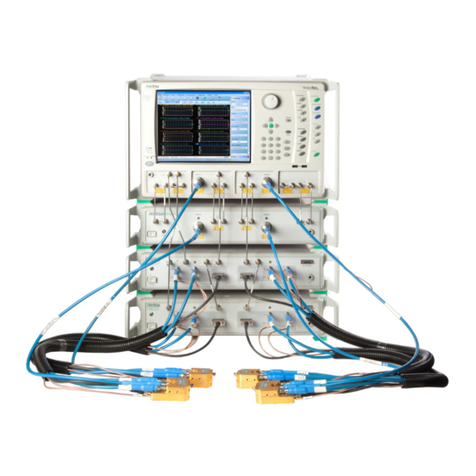
Anritsu
Anritsu VectorStar ME7838G4 quick start guide
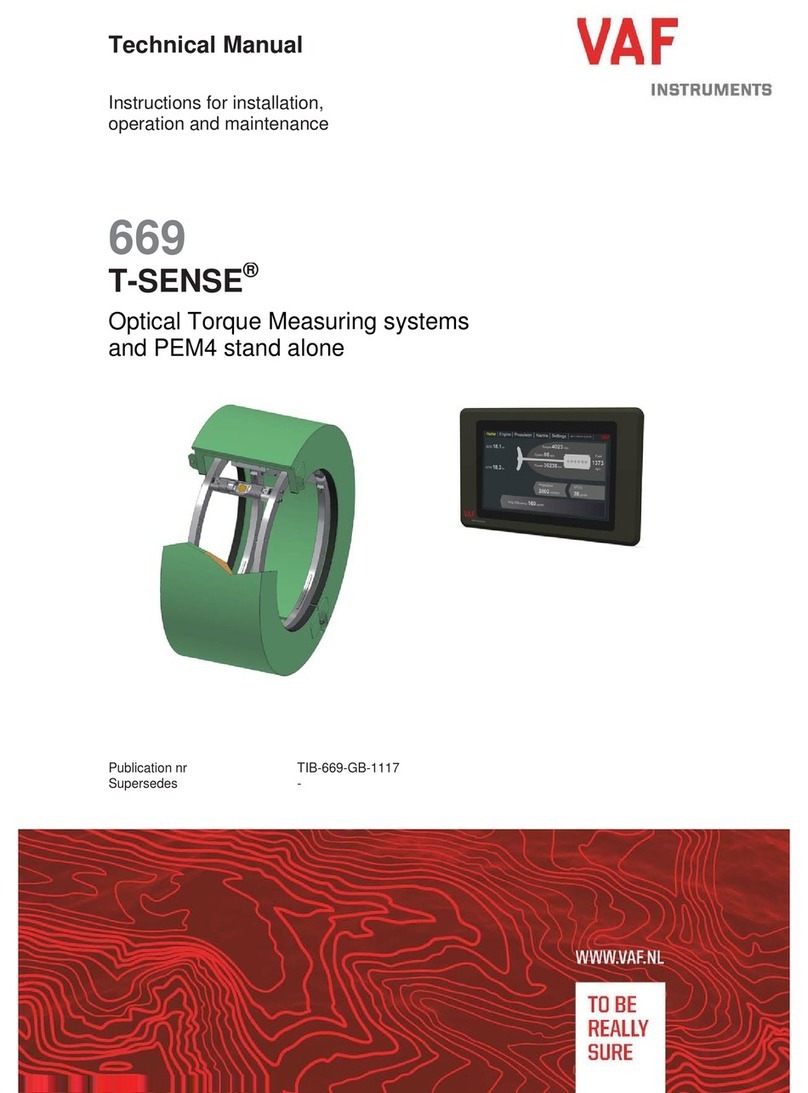
VAF instruments
VAF instruments T-SENSE Technical manual
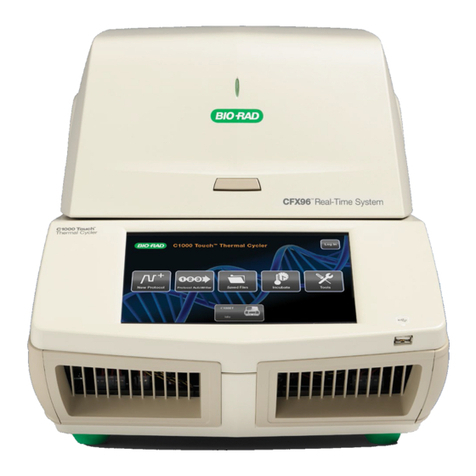
BIO RAD
BIO RAD CFX96 Touch Installation quick guide
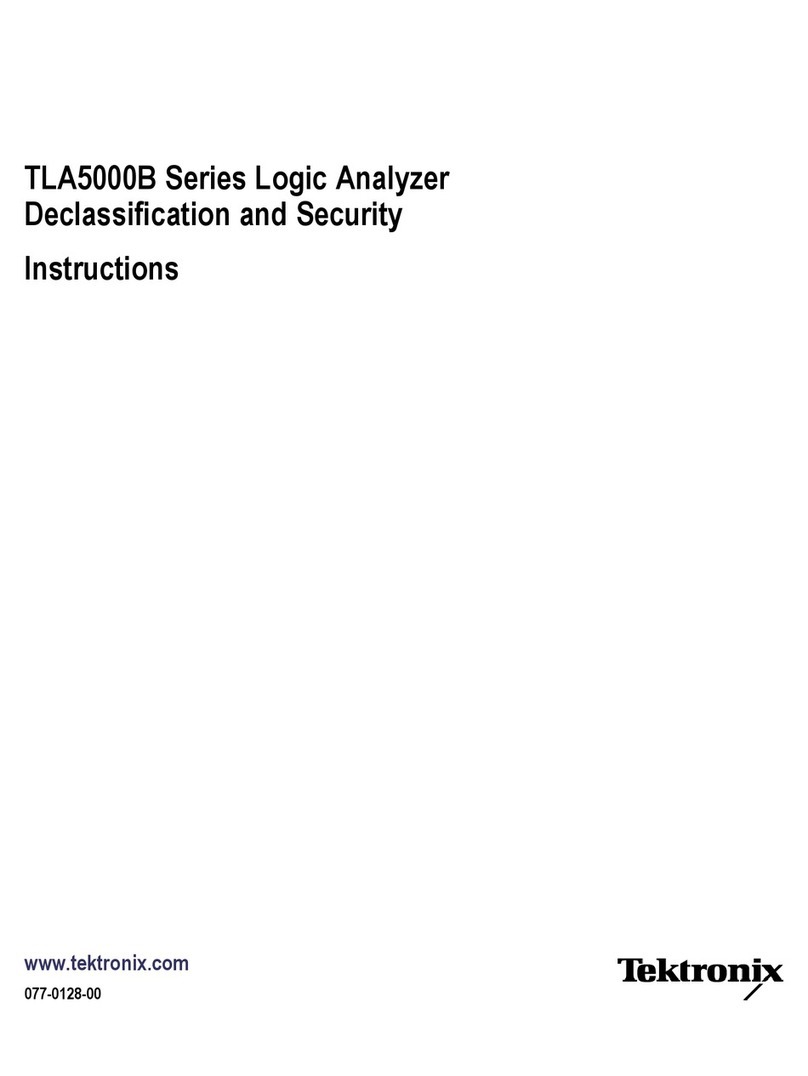
Tektronix
Tektronix TLA5000B Series Declassification and security instructions
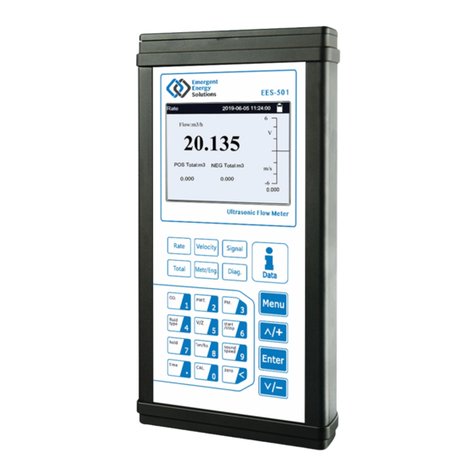
EMERGENT
EMERGENT EES-501 instruction manual
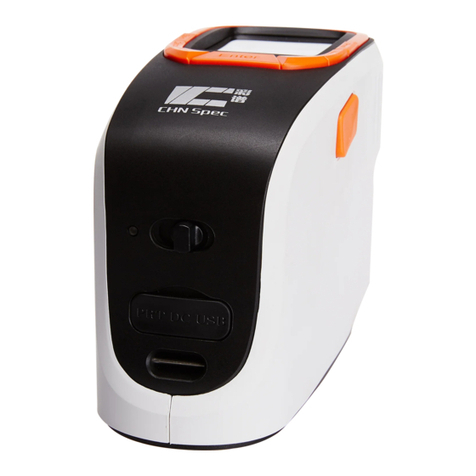
CHN Spec
CHN Spec CS-580 Operation manual
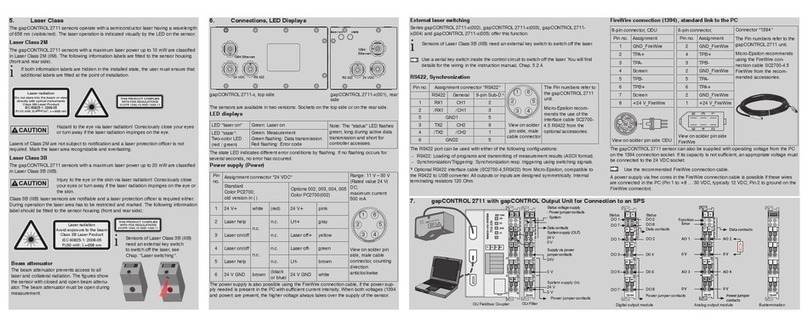
MICRO-EPSILON
MICRO-EPSILON gapCONTROL 2711 Assembly instructions

Kiwitron
Kiwitron Dista-Safe manual
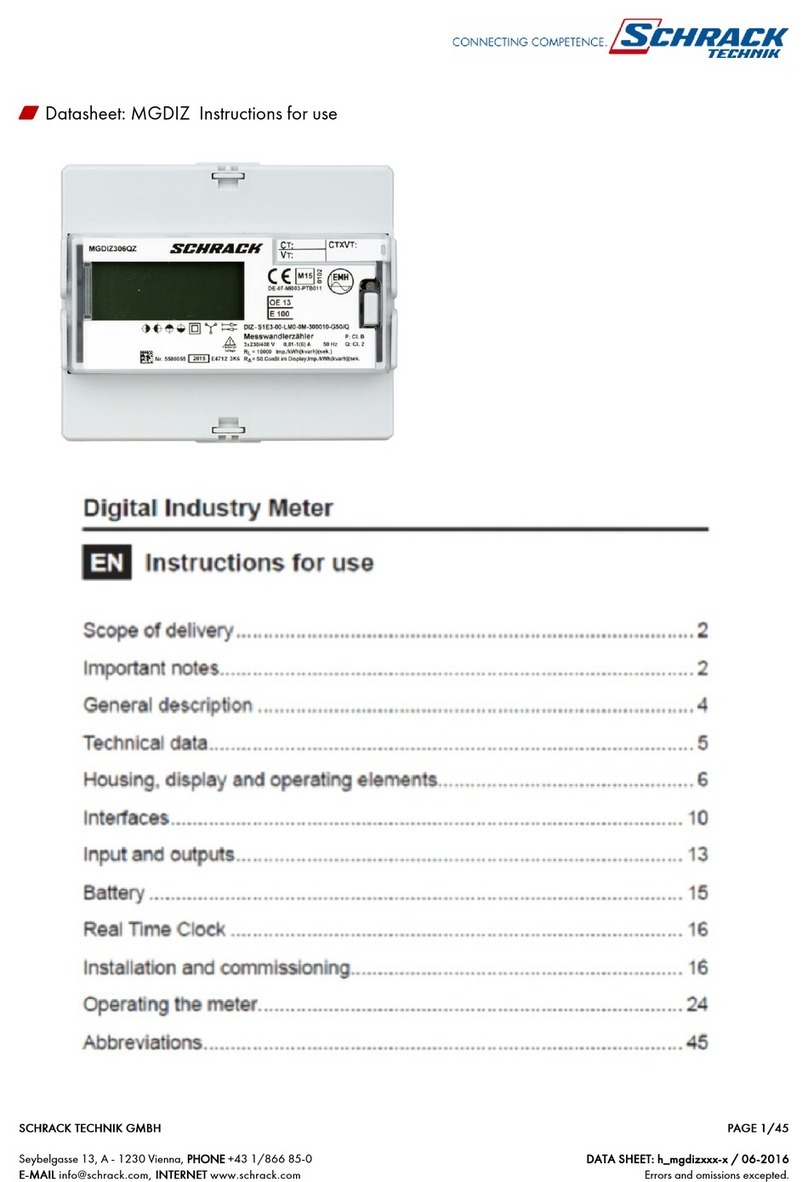
Schrack
Schrack MGDIZ Series Instructions for use
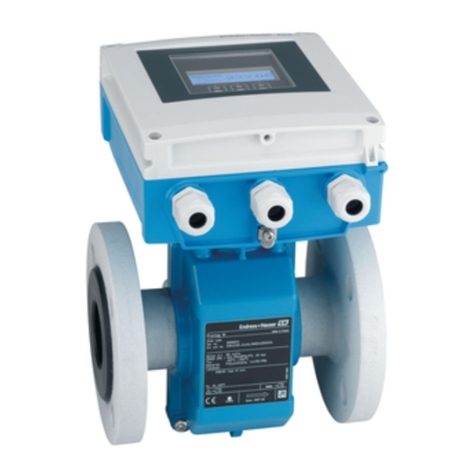
Endress+Hauser
Endress+Hauser Proline Promag W 800 operating instructions
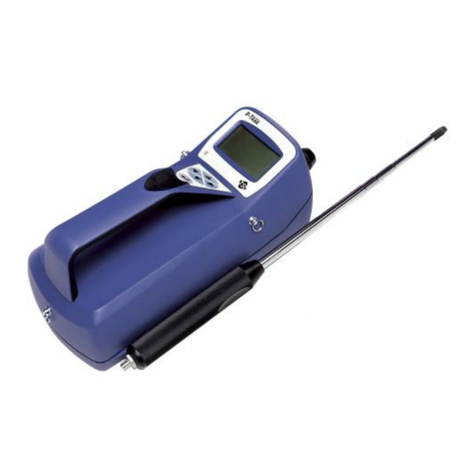
TSI Instruments
TSI Instruments P-TRAK Ultrafine Operation and service manual

GREISINGER
GREISINGER 4016138956801 manual
